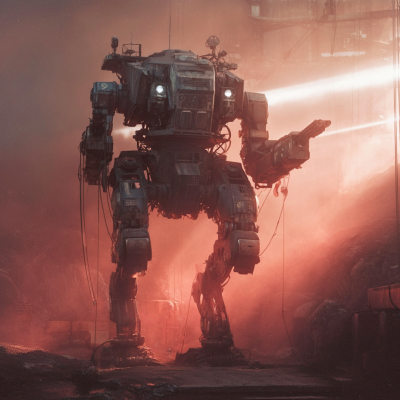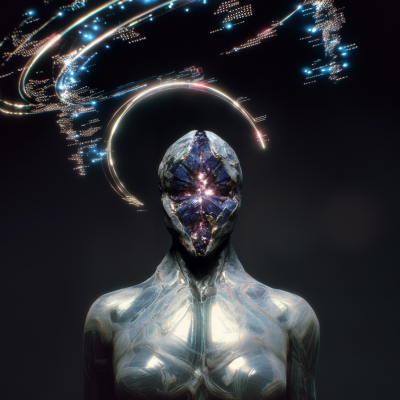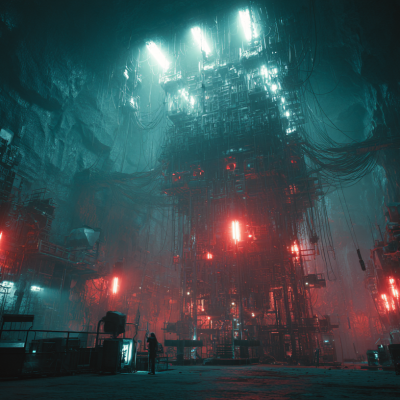“How do you actually write these stories with AI?”
It’s the question I get most often, usually phrased with varying degrees of curiosity, skepticism, or genuine interest in the process. So let’s pull back the curtain completely and show you exactly how a chapter of Fall of the Titans goes from concept to completion.
This isn’t going to be a defense of using AI, nor is it going to be a tutorial. It’s simply the truth of my creative process—messy, iterative, and constantly evolving.
The Foundation: World-Building Documents
Before I touch any AI tool, before I write a single line, I spend weeks (sometimes months) building the foundation. For Fall of the Titans II, this meant creating several key documents:
Character Profiles – Deep dives into every major and supporting character. Not just their physical descriptions, but their philosophies, speaking patterns, relationships, and arcs. For William Falck alone, I wrote pages about his internal conflict, his Divergent evolution, his relationship with Dire Wulf’s ghost, and his complex feelings about his father.
Writing Samples – Examples of strong and weak prose in the style I want. I analyzed what works and what doesn’t—how to handle combat scenes, emotional moments, world-building exposition. These became my style guide.
Literary Mission – A document outlining what kind of story I’m telling, what traditions I’m drawing from (Gundam, Evangelion, Titanfall, military SF), and what themes I’m exploring. This keeps me focused when the story threatens to drift.
Audience Profile – Understanding who I’m writing for helps me make better decisions. The “Contemplative Veteran” reader persona—someone who wants both action and philosophy, who appreciates moral complexity—guides every chapter.
These documents took months to develop. They represent hundreds of hours of thinking, revising, and refining before any actual story chapters were written.
The Process: From Concept to Chapter
Here’s how a typical chapter comes together:
Step 1: The Vision (All Human)
I start with a clear vision of what needs to happen in the chapter. For example, “Chapter 20: The Wulf at the Door” needed to accomplish several things:
- Krueger’s moral awakening through Soul Prism contact
- The revelation about his daughter Elsa being trapped
- The Wulf Pack’s defection from Ares
- Building tension before the Titan facility assault
I sketch out the emotional beats, the key dialogue moments, and the thematic weight. This is pure human creativity—the AI has no input here.
Step 2: The Collaboration Begins
Once I know what the chapter needs to accomplish, I work with Claude (the AI you’re talking to right now, actually) to develop it. But here’s the crucial part: I’m the director, the editor, and the final authority.
I provide Claude with:
- The world-building documents
- The specific chapter outline
- Key dialogue or moments I’ve already envisioned
- The emotional tone I want
- References to earlier chapters for continuity
Claude then generates a draft based on these instructions. But it’s not autonomous—it’s a collaborative conversation. I’ll say things like:
“This dialogue feels too formal. Krueger is breaking down emotionally. Make it rawer.”
“The pacing in this combat scene is wrong. We need shorter sentences, more urgency.”
“You’re explaining the Soul Prism mechanics too much. Trust the reader to understand.”
Step 3: The Refinement (Very Human)
The first draft from this collaboration is never the final product. I read through it multiple times, making extensive edits:
- Voice consistency – Does Falck sound like Falck? Is Ares appropriately cold and certain?
- Thematic alignment – Are we exploring the cost of using Soul Prisms, the nature of consciousness, the weight of family legacy?
- Musical rhythm – Does the prose flow with the kind of rhythm I want in the soundtrack?
- Emotional authenticity – Do the moments of grief, rage, hope, or terror feel earned?
I’ll rewrite entire sections if they don’t hit right. Sometimes I’ll scrap a draft completely and start over with a different approach.
Step 4: The Integration
Each chapter needs to work as:
- A standalone piece of writing
- Part of the larger Act structure
- A companion to its musical track
- A building block in character arcs that span multiple books
I track continuity obsessively. If Falck’s left shoulder was injured in Chapter 2, he better still be favoring it in Chapter 5. If Dire Wulf’s ghost “pulsed with unease” in one scene, that language pattern needs to remain consistent.
This is where having detailed world-building documents becomes essential. They’re my bible for consistency.
What AI Brings to the Table
Let me be specific about what the AI collaboration actually provides:
Speed of iteration – I can explore multiple versions of a scene quickly. Want to see how a conversation plays out with different emotional tones? I can generate three variations in minutes and choose the best one.
Consistency checking – With extensive character profiles loaded, the AI helps maintain voice consistency across 20+ chapters.
World-building expansion – When I need technical details about Robot Core specifications or the physics of Titan’s atmosphere, AI helps me maintain scientific plausibility.
Structural feedback – “This chapter has too much exposition and not enough action” or “The emotional beat needs more buildup” are the kinds of insights that emerge from the collaboration.
Tireless patience – I can iterate fifteen times on a single paragraph until it’s perfect. An AI doesn’t get frustrated or tired.
What AI Doesn’t Bring
Here’s what AI cannot do, no matter how advanced:
Emotional truth – The AI doesn’t know what it feels like to lose a parent, to betray someone you trust, or to become something more and less than human. Those emotions come from me.
Thematic vision – The AI doesn’t care about exploring consciousness as currency, or father-son relationships, or the cost of survival. That’s my obsession driving the story.
Taste and judgment – Deciding what works and what doesn’t, what feels authentic versus what feels manufactured—that’s human intuition.
The burning feeling – That thing I mentioned in the first post, the reason I’m compelled to tell this story? AI doesn’t have that. It’s uniquely mine.
The Uncomfortable Truth
Here’s something I’ve realized through this process: using AI to help write raises uncomfortable questions about creativity, authorship, and artistic value. I don’t have all the answers to those questions.
What I do know is this: the story that’s emerging from this collaboration is one I couldn’t have created alone in any reasonable timeframe. Not with the scope, consistency, and polish it has. But it’s also not a story the AI could have created without me—my vision, my emotional investment, my thousands of hours of world-building and revision.
Is it “real” writing? I think that’s for readers to decide. I’m not interested in gatekeeping creativity or defining what “counts” as art. I’m interested in telling the best story I possibly can with the tools available to me.
The Music Side
I should note: my music production workflow is completely different. When I’m in the studio working on the soundtrack, there’s no AI involvement.
It’s me, my synthesizers, my DAW (Digital Audio Workstation), and my ears. I’m choosing every sound, crafting every melody, making every mixing decision. The music is the part of this project that’s most purely “me” in the traditional sense.
Why keep music AI-free? Partially because the tools aren’t there yet for the kind of cinematic, progressive sound I’m crafting. But mostly because music is where I feel most fluent, most confident. I don’t need collaboration there—I know how to speak that language.
Writing, on the other hand? I’m constantly learning, constantly pushing against my limitations. That’s where collaboration helps me reach higher than I could alone.
The Tools I Actually Use
For transparency, here’s my actual toolkit:
Writing:
- Claude (Anthropic) for collaborative story development
- Microsoft Word for version control of the story
Music Production:
- Reason 13 as my main DAW
- Various synthesizers (I’ll detail these in future music-focused posts)
Visual Assets:
- Midjourney for concept art and chapter illustrations
- Various AI video tools for promotional material (experimenting with RunwayML and others)
Voice Acting:
- Artlist.io for character voices
- Extensive direction and editing to match character personalities
I’m still experimenting with workflow, still finding better ways to integrate these tools. Part of why I’m documenting this publicly is to create a record of how these processes evolve.
What’s Next in the Process
Right now I’m in the music production and visualisation of the story.
Each chapter gets at least three full revision passes before I consider it ready. Then it needs to align with its musical companion piece, which often leads to more revisions.
The Question I Keep Asking Myself
Am I cheating somehow by using these tools?
I don’t think so, but I understand why some people might feel that way. What I keep coming back to is this: every technological advancement in art has been met with skepticism. Photography wasn’t “real” art. Synthesizers weren’t “real” instruments. Digital painting wasn’t “real” painting.
Now we recognize all of those as legitimate artistic mediums with their own masters and masterpieces.
Maybe AI-assisted writing will follow the same path. Maybe it won’t. But I’m not waiting for consensus—I’m too obsessed with getting this story out of my system to worry about whether I’m using the “right” tools.
Your Turn
I’m genuinely curious about your thoughts on this process. Does knowing the details change how you feel about the story? Does the collaboration model I’ve described seem like authorship to you, or something else?
I’m not looking for validation—I’m going to keep making this project regardless. But I am interested in the conversation, in understanding how people engage with art created through these new processes.
Next week, I’ll dive into the music production side: how I’m crafting the sonic landscape of Acts III and IV, and how the musical tracks inform and reshape the narrative chapters.
Until then, keep your shields up and your Soul Prisms charged.
The march to Titan continues.
— Millennium Falck





